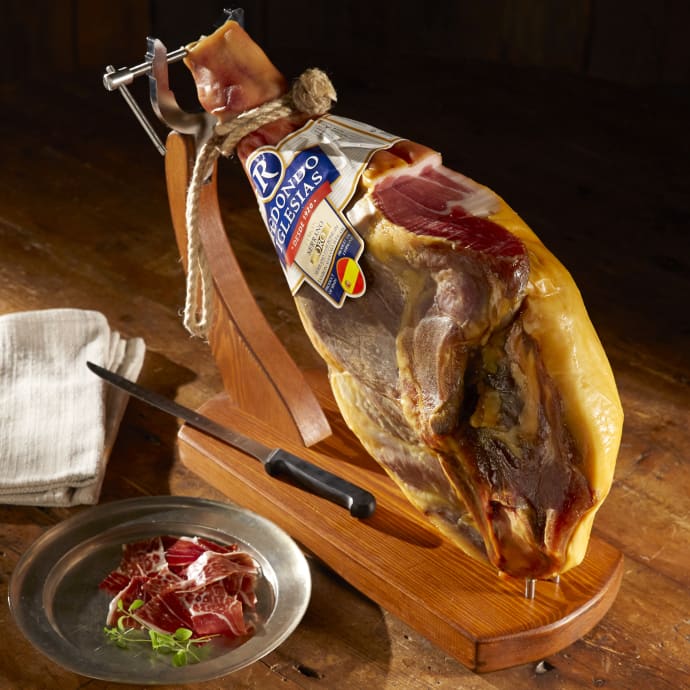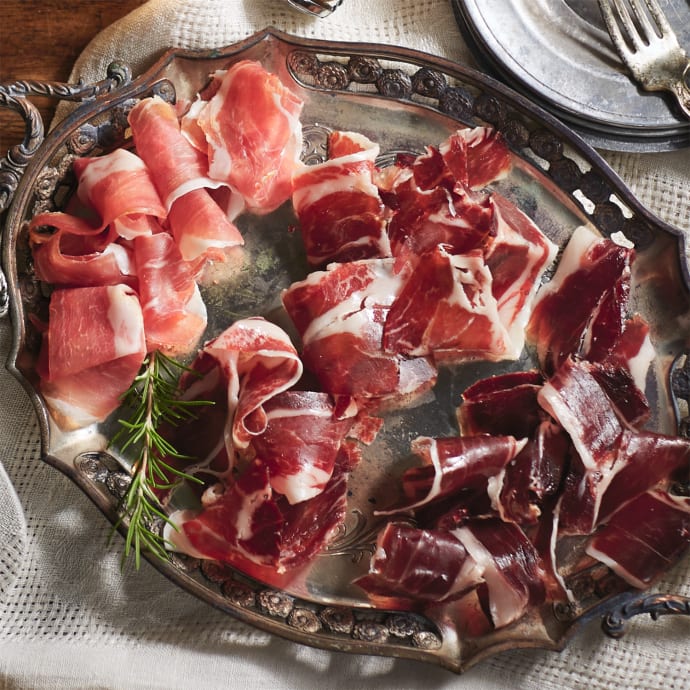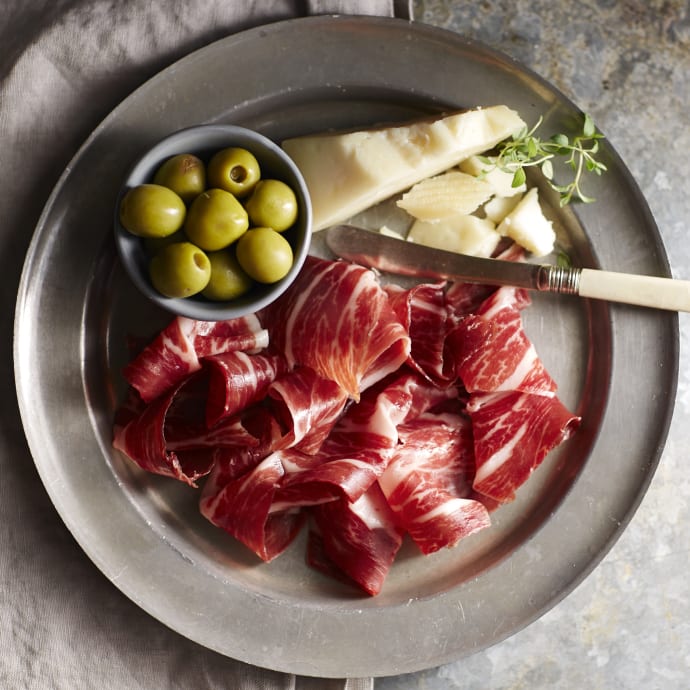
Ham That Can Hang Uptown
The Washington Post
-
January 25, 2006
Turning Virginia's Dry-Cured Pride Into New-World Prosciutto
Walter Nicholls
Fulks Run, VA - It's safe to say that none of Ron Turner's neighbors along the North Fork of the Shenandoah River, west of New Market, would dream of eating raw country ham. But the owner of Turner Ham House knows that his uncooked, 1-year-old ham can be thinly sliced and served like prosciutto, the $25-per-pound Italian import.
"You can take our ham and do everything you do with prosciutto," said Turner.
For generations, rural families in Virginia have been curing the hams that are a mainstay of Southern cooking. But now they believe that their $2.99-per-pound whole hams -- when cured for a year rather than the usual 70 days -- can compete successfully with elite salt-cured and air-dried European varieties. Even the U.S. government agrees that they are essentially the same product.
Pork purveyors plan to meet in Williamsburg in late March to come up with a strategy. They maintain that country ham, like fine wine, improves with age, and they want the public to take a fresh look.
They also want to change the way Americans think about cured pork, the way they eat it and even what they call it. Ham man Sam Edwards III, president of S. Wallace Edwards & Sons of Surry, Va., has a name in mind. Heritage Ham, anyone?
* * *
The basic curing procedure is essentially the same at most ham houses and hasn't changed since Jamestown colonists learned the secrets of meat curing from local Indians. The fresh, or green, hams, which come from the hind legs of hogs, are hand-rubbed with "flake salt" and a small amount of sodium nitrate. The salt preserves the meat, while the sodium nitrate sets the tawny, terra cotta color.
On a recent afternoon at the Turner Ham House, about 2,000 fresh, plump hams arrive for processing. For the Turners, it's a busy day -- the first day of the ham year.
Turner, 42, appears fit and natty in a matching work shirt and hat with the company logo. He's a fourth-generation ham man. His temperature- and humidity-controlled warehouse, built in 1966 and filled with drying pork, has a musky aroma. The warehouse sits on the bank of the river, next to the family's well-maintained croquet court and the Fulks Run Grocery that Turner runs with his wife Peggie.
Turner adds brown sugar to his cure, "rubbing it in on the butt and packing it into the hock, just like my great-grandfather did." After about seven weeks, the hams are washed and hung in net bags to dry, hocks up. After a minimum of 70 days of drying time, the legs can be sold as country ham. If dried for a year, the hams shrink and lose 25 to 30 percent of their weight. (Essentially, country ham and Smithfield ham are the same thing. But to carry the Smithfield name, the ham must be processed inside the corporate limits of Smithfield, Va.)
Turner would prefer to sell most of his cured hams in early summer to vendor at carnivals and country fairs, for the very practical reason that "the longer you have them, the longer the money is tied up with hams just hanging there." At the moment, Turner views the promotion of country ham as prosciutto as "just a side market we're playing with."
He does sell a relatively small amount of raw, cured ham that has been dried for a full year, usually to Washington area customers who make the 130-mile drive to his ham house. "They are always so excited when they get it," he said. The flavor is at first salty, then nutty and mellow.
We brought some of Turner's aged country ham to Santi Zabaleta, executive chef of the Spanish restaurant Taberna Del Alabardero, to sample in a blind taste test. Just inside the door of the downtown Washington restaurant is an ornate, five-seat tapas bar where a whole leg of Serrano ham is displayed on a carving stand.
Zabaleta took a bite of the Virginia country ham. It was, he said, "a little musty and very salty." After being told of the ham's provenance, he reached for more. And after another taste, Zabaleta amended his opinion.
"I'm pleasantly surprised. For what it is, it's very good for cooking, say, with green beans or stuffed into trout. I'd use it and promote this ham."
* * *
Candace Cansler, executive director of the Conover, N.C.-based National Country Ham Association, plans to attend the Williamsburg strategy session. "Our most serious issue is how to promote country ham as prosciutto and compete with imported ham, because it's the same product," she said.
Robert Post, director of labeling and consumer protection at the U.S. Food Safety and Inspection Service, confirms that as far as the U.S. Department of Agriculture is concerned, "country ham and prosciutto have the same requirements for how much and for how long salt and nitrates are applied and a drying time of not less than 70 days. They need only meet the standards of identity for dry-cured ham." More than 19 million pounds of dry-cured ham was imported to the United States from January to November 2005, most significantly from Canada, Italy, Germany and Spain.
Cansler is well aware that imported ham is perceived as being more valuable than its domestic country cousin and that it commands a higher price. At Turner Ham House, for example, a whole bone-in, 1-year-old leg that weighs 13 pounds goes for $39 (Turner also sells quarter-pound packages of boneless, sliced ham at $19.99 per pound). At Dean & DeLuca in Georgetown, prosciutto imported from Parma, Italy, or Serrano ham from Spain costs about $25 a pound.
So if domestic cured ham is made the same way as prosciutto and it tastes about the same, what's holding it back? Cansler is convinced that an image change is in order. And a name change -- something that would bring a new cachet to the product -- wouldn't hurt either. "We're considering Premium USA Hams," she said.
Importers, meanwhile, are raising the stakes. Next year, a Spanish ham called jamon Iberico will be available in the United States for the first time. It's produced from descendants of black-hoofed wild boars that forage for acorns in oak forests of southern and southwestern Spain and is said to have a gamey flavor and firm texture that comes from being aged for two to four years. The price will be about $1,000 for a 14-pound leg. Spanish importer La Tienda of Williamsburg says it already has accepted more than 200 orders.
Country ham purveyors are up against more than importers. Their neighbors, and their neighbors' children, also will need to be brought around if country ham is to become competitive with imported products.
"People around here, they're not eating melon balls wrapped with country ham," Turner said. Among country ham enthusiasts, who live primarily in the Southeast, a favorite way to prepare ham that has been cured an average of three to four months or longer is to roll slices in flour and fry them on the griddle. "That's what they like," Turner said. "That's what they have done for generations."
One of Cansler's strategies is to find ways to make country ham appeal to younger eaters by packaging it differently and in ready-to-eat portions. "Why, there was a 12-year-old boy in my house for breakfast the other day who had never had country ham before," she said. She told him it would taste like a McDonald's french fry. After a bite he said only, "Too salty."
Country ham, Cansler said, "may be an acquired taste. We have to fix that. We must reach the next generation."
© 2006 The Washington Post Company
Walter Nicholls
Fulks Run, VA - It's safe to say that none of Ron Turner's neighbors along the North Fork of the Shenandoah River, west of New Market, would dream of eating raw country ham. But the owner of Turner Ham House knows that his uncooked, 1-year-old ham can be thinly sliced and served like prosciutto, the $25-per-pound Italian import.
"You can take our ham and do everything you do with prosciutto," said Turner.
For generations, rural families in Virginia have been curing the hams that are a mainstay of Southern cooking. But now they believe that their $2.99-per-pound whole hams -- when cured for a year rather than the usual 70 days -- can compete successfully with elite salt-cured and air-dried European varieties. Even the U.S. government agrees that they are essentially the same product.
Pork purveyors plan to meet in Williamsburg in late March to come up with a strategy. They maintain that country ham, like fine wine, improves with age, and they want the public to take a fresh look.
They also want to change the way Americans think about cured pork, the way they eat it and even what they call it. Ham man Sam Edwards III, president of S. Wallace Edwards & Sons of Surry, Va., has a name in mind. Heritage Ham, anyone?
* * *
The basic curing procedure is essentially the same at most ham houses and hasn't changed since Jamestown colonists learned the secrets of meat curing from local Indians. The fresh, or green, hams, which come from the hind legs of hogs, are hand-rubbed with "flake salt" and a small amount of sodium nitrate. The salt preserves the meat, while the sodium nitrate sets the tawny, terra cotta color.
On a recent afternoon at the Turner Ham House, about 2,000 fresh, plump hams arrive for processing. For the Turners, it's a busy day -- the first day of the ham year.
Turner, 42, appears fit and natty in a matching work shirt and hat with the company logo. He's a fourth-generation ham man. His temperature- and humidity-controlled warehouse, built in 1966 and filled with drying pork, has a musky aroma. The warehouse sits on the bank of the river, next to the family's well-maintained croquet court and the Fulks Run Grocery that Turner runs with his wife Peggie.
Turner adds brown sugar to his cure, "rubbing it in on the butt and packing it into the hock, just like my great-grandfather did." After about seven weeks, the hams are washed and hung in net bags to dry, hocks up. After a minimum of 70 days of drying time, the legs can be sold as country ham. If dried for a year, the hams shrink and lose 25 to 30 percent of their weight. (Essentially, country ham and Smithfield ham are the same thing. But to carry the Smithfield name, the ham must be processed inside the corporate limits of Smithfield, Va.)
Turner would prefer to sell most of his cured hams in early summer to vendor at carnivals and country fairs, for the very practical reason that "the longer you have them, the longer the money is tied up with hams just hanging there." At the moment, Turner views the promotion of country ham as prosciutto as "just a side market we're playing with."
He does sell a relatively small amount of raw, cured ham that has been dried for a full year, usually to Washington area customers who make the 130-mile drive to his ham house. "They are always so excited when they get it," he said. The flavor is at first salty, then nutty and mellow.
We brought some of Turner's aged country ham to Santi Zabaleta, executive chef of the Spanish restaurant Taberna Del Alabardero, to sample in a blind taste test. Just inside the door of the downtown Washington restaurant is an ornate, five-seat tapas bar where a whole leg of Serrano ham is displayed on a carving stand.
Zabaleta took a bite of the Virginia country ham. It was, he said, "a little musty and very salty." After being told of the ham's provenance, he reached for more. And after another taste, Zabaleta amended his opinion.
"I'm pleasantly surprised. For what it is, it's very good for cooking, say, with green beans or stuffed into trout. I'd use it and promote this ham."
* * *
Candace Cansler, executive director of the Conover, N.C.-based National Country Ham Association, plans to attend the Williamsburg strategy session. "Our most serious issue is how to promote country ham as prosciutto and compete with imported ham, because it's the same product," she said.
Robert Post, director of labeling and consumer protection at the U.S. Food Safety and Inspection Service, confirms that as far as the U.S. Department of Agriculture is concerned, "country ham and prosciutto have the same requirements for how much and for how long salt and nitrates are applied and a drying time of not less than 70 days. They need only meet the standards of identity for dry-cured ham." More than 19 million pounds of dry-cured ham was imported to the United States from January to November 2005, most significantly from Canada, Italy, Germany and Spain.
Cansler is well aware that imported ham is perceived as being more valuable than its domestic country cousin and that it commands a higher price. At Turner Ham House, for example, a whole bone-in, 1-year-old leg that weighs 13 pounds goes for $39 (Turner also sells quarter-pound packages of boneless, sliced ham at $19.99 per pound). At Dean & DeLuca in Georgetown, prosciutto imported from Parma, Italy, or Serrano ham from Spain costs about $25 a pound.
So if domestic cured ham is made the same way as prosciutto and it tastes about the same, what's holding it back? Cansler is convinced that an image change is in order. And a name change -- something that would bring a new cachet to the product -- wouldn't hurt either. "We're considering Premium USA Hams," she said.
Importers, meanwhile, are raising the stakes. Next year, a Spanish ham called jamon Iberico will be available in the United States for the first time. It's produced from descendants of black-hoofed wild boars that forage for acorns in oak forests of southern and southwestern Spain and is said to have a gamey flavor and firm texture that comes from being aged for two to four years. The price will be about $1,000 for a 14-pound leg. Spanish importer La Tienda of Williamsburg says it already has accepted more than 200 orders.
Country ham purveyors are up against more than importers. Their neighbors, and their neighbors' children, also will need to be brought around if country ham is to become competitive with imported products.
"People around here, they're not eating melon balls wrapped with country ham," Turner said. Among country ham enthusiasts, who live primarily in the Southeast, a favorite way to prepare ham that has been cured an average of three to four months or longer is to roll slices in flour and fry them on the griddle. "That's what they like," Turner said. "That's what they have done for generations."
One of Cansler's strategies is to find ways to make country ham appeal to younger eaters by packaging it differently and in ready-to-eat portions. "Why, there was a 12-year-old boy in my house for breakfast the other day who had never had country ham before," she said. She told him it would taste like a McDonald's french fry. After a bite he said only, "Too salty."
Country ham, Cansler said, "may be an acquired taste. We have to fix that. We must reach the next generation."
© 2006 The Washington Post Company
Other Press
A trio of savory snacks to enjoy this fall
Atlanta Journal-Counstitution
-
November 1, 2024
The 15 Best Gifts for People Who Love Food
Wirecutter
-
October 23, 2024
This Classic Garlic Keeper Is the One Thing I Made Sure I Brought Back from Spain
The Kitchn
-
July 10, 2024
That's How the Light Gets In
Defense Visual Information Distribution Service
-
April 20, 2024
Featured Products
 SALE
SALEBone-In Jamón Serrano by Redondo Iglesias - FREE SHIPPING!
JM-04
(8)
$399.00 $349.00
 SALE
SALECinco Jotas Bone-In 100% Ibérico de Bellota Jamón - FREE SHIPPING!
JM-106
$1,499.00 $1,299.00

Cured Meats of Spain Sampler
JM-45
(30)
$99.00$99.00

Jamón Tasting Trio of Sliced Ham
JM-25
(30)
$79.00$79.00

Sliced Ibérico de Bellota Ham by Peregrino, Nitrate Free - 2 oz
JM-52
(44)
$39.00$39.00

Sliced Ibérico Ham by Peregrino, Nitrate Free - 2 oz
JM-23
(33)
$23.00$23.00






